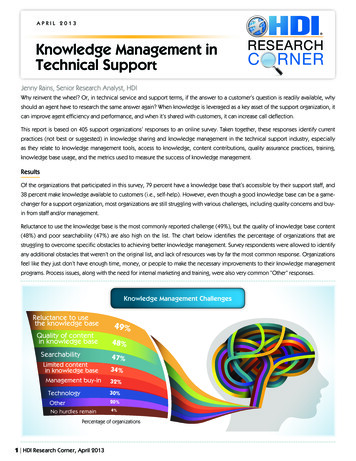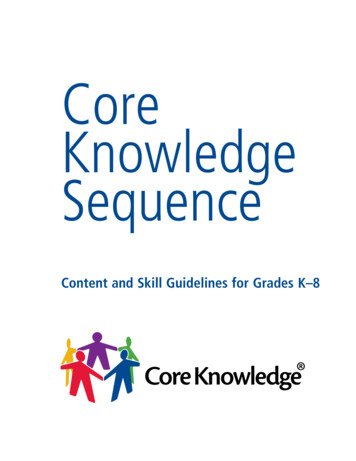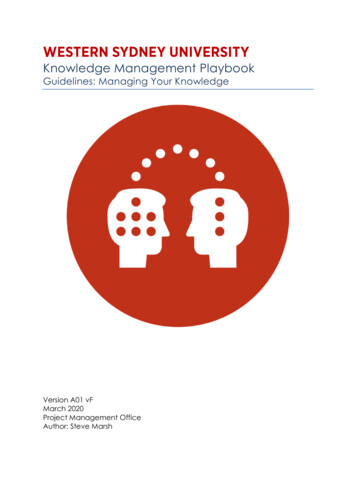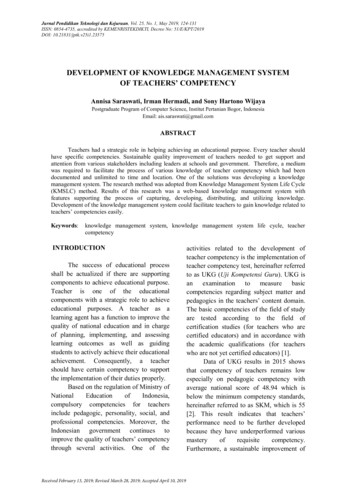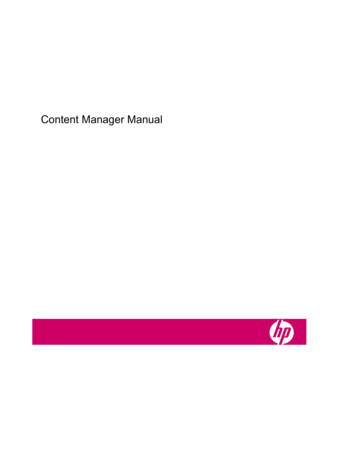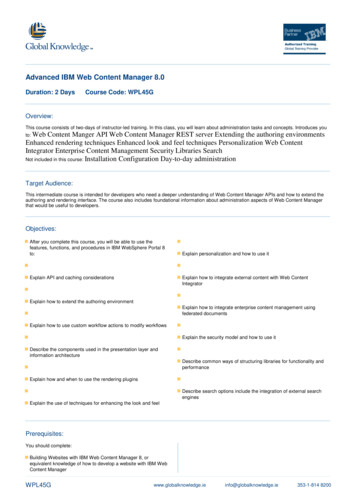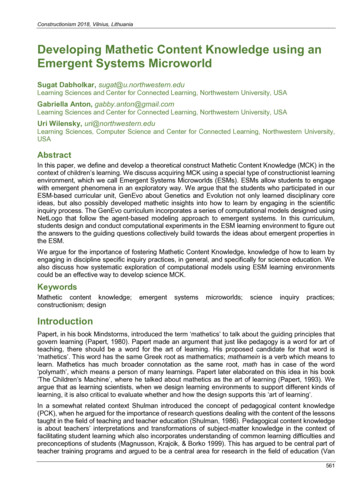
Transcription
Constructionism 2018, Vilnius, LithuaniaDeveloping Mathetic Content Knowledge using anEmergent Systems MicroworldSugat Dabholkar, sugat@u.northwestern.eduLearning Sciences and Center for Connected Learning, Northwestern University, USAGabriella Anton, gabby.anton@gmail.comLearning Sciences and Center for Connected Learning, Northwestern University, USAUri Wilensky, uri@northwestern.eduLearning Sciences, Computer Science and Center for Connected Learning, Northwestern University,USAAbstractIn this paper, we define and develop a theoretical construct Mathetic Content Knowledge (MCK) in thecontext of children’s learning. We discuss acquiring MCK using a special type of constructionist learningenvironment, which we call Emergent Systems Microworlds (ESMs). ESMs allow students to engagewith emergent phenomena in an exploratory way. We argue that the students who participated in ourESM-based curricular unit, GenEvo about Genetics and Evolution not only learned disciplinary coreideas, but also possibly developed mathetic insights into how to learn by engaging in the scientificinquiry process. The GenEvo curriculum incorporates a series of computational models designed usingNetLogo that follow the agent-based modeling approach to emergent systems. In this curriculum,students design and conduct computational experiments in the ESM learning environment to figure outthe answers to the guiding questions collectively build towards the ideas about emergent properties inthe ESM.We argue for the importance of fostering Mathetic Content Knowledge, knowledge of how to learn byengaging in discipline specific inquiry practices, in general, and specifically for science education. Wealso discuss how systematic exploration of computational models using ESM learning environmentscould be an effective way to develop science MCK.KeywordsMathetic content knowledge;constructionism; ctices;IntroductionPapert, in his book Mindstorms, introduced the term ‘mathetics’ to talk about the guiding principles thatgovern learning (Papert, 1980). Papert made an argument that just like pedagogy is a word for art ofteaching, there should be a word for the art of learning. His proposed candidate for that word is‘mathetics’. This word has the same Greek root as mathematics; mathamein is a verb which means tolearn. Mathetics has much broader connotation as the same root, math has in case of the word‘polymath’, which means a person of many learnings. Papert later elaborated on this idea in his book‘The Children’s Machine’, where he talked about mathetics as the art of learning (Papert, 1993). Weargue that as learning scientists, when we design learning environments to support different kinds oflearning, it is also critical to evaluate whether and how the design supports this ‘art of learning’.In a somewhat related context Shulman introduced the concept of pedagogical content knowledge(PCK), when he argued for the importance of research questions dealing with the content of the lessonstaught in the field of teaching and teacher education (Shulman, 1986). Pedagogical content knowledgeis about teachers’ interpretations and transformations of subject-matter knowledge in the context offacilitating student learning which also incorporates understanding of common learning difficulties andpreconceptions of students (Magnusson, Krajcik, & Borko 1999). This has argued to be central part ofteacher training programs and argued to be a central area for research in the field of education (Van561
Constructionism 2018, Vilnius, LithuaniaDriel, Verloop, & de Vos, 1998). With more incorporation of technology in education, the idea of PCKhas been extended to Technology-enhanced PCK (TPCK) (Niess, 2005). Niess (2005) mentions thatwith technology becoming an integral component or tool for learning, science and mathematics teachersmust develop an overarching conception of their subject matter and what it means to teach withtechnology. All these constructs focus on role of teachers and on the art of teaching. In this paper, wecombine these two strands the art of teaching in the context of subject-specific knowledge andtechnology, and the art of learning, which we call Mathetic Content Knowledge.Each discipline has a discipline specific practices of engaging in inquiry and construction of knowledge.MCK is strongly connected to these discipline specific practices. The art of learning and being good atthis art is different for mathematics, languages, history or sciences. We argue that Emergent SystemsSandbox (ESM), a special kind of constructionist learning environment, allows students to develop MCKin the context of the inquiry practices they engage in. ESMs are a specifically designed to supportstudents in creating, exploring, and sharing virtual models and model-based artifacts of dynamicsystems that exhibit emergent phenomena. In this paper, we discuss how students develop MCK whenlearn genetics and evolution using an ESM-based curriculum called GenEvo.Research in mathematics and science education over the past few decades has investigated and shownthe effectiveness of model-based inquiry in classrooms, both in fostering students’ thinking skills and inlearning of mathematical and scientific concepts. Specifically, researchers have demonstrated thatlearning based on investigations of models leads to development of competence in disciplinary inquirypractices such as constructing argumentation based on evidence and communicating it effectively toothers (Passmore & Svoboda, 2012; Windschitl et al., 2008; Schwarz et al. 2009) as well as can supportcontent mastery (Stewart et al. 2005). The Next Generation Science Standards (NGSS) stipulatedeveloping and using models as one of the eight core scientific practices (NGSS Lead States, 2013).In particular, these standards suggest that models should be developed ‘‘to predict and showrelationships among variables between systems and their components in the natural and designedworlds’’. We demonstrate that model-based inquiry using with an ESM goes beyond merely engagingstudents this specific scientific inquiry practices; in another paper, we have argued elsewhere that thestudents that participated in our ESM-based curriculum meaningfully engaged students in several otherinquiry science practices recommended by the NGSS (Dabholkar et al., 2018). Engaging meaningfullyin scientific inquiry practices is critical to develop Mathetic Content Knowledge for science. As studentsconstruct their own knowledge in a microworld by engaging in scientific inquiry practices, such asconstructing explanations and engaging in arguments using evidence, they also understand thescientific process of knowledge construction. This understanding is critical for developing MCK forscience.GenEvo: An ESM-based curriculum about genetics and evolutionThe GenEvo curriculum incorporates a series of computational models designed using NetLogo(Dabholkar et al., 2016). NetLogo is an agent-based modeling software that has been used for researchwork regarding emergent systems as well as to design educational curricular units (Wilensky, 1999).The design of computational models in the GenEvo follows the agent-based modeling approach toemergent systems that has been demonstrated to be effective for fostering deep understanding ofdisciplinary core ideas (e.g., electricity, the particulate nature of matter) as well as crosscutting ideassuch as complex systems thinking and computational thinking (Blikstein & Wilensky, 2004; Levy &Wilensky, 2006; Wilkerson-Jerde & Wilensky, 2010).In this curriculum, students are first presented with a computational model of a bacterial cell with agenetic circuit in which certain components interact in specific manner (See Figure 1) (Dabholkar et al.,2016).The students explore and play with the model to figure out these interactions and engineer the geneticcircuit to make their cells ‘fitter’ to reproduce. In the next two subunits, students explore and tinker withthe models of genetic drift and natural selection. Finally, the cells where genetic circuits are designedby the students will ‘compete for survival’ in a limited resource environment. These computationalmodels are intestinally designed specifically from the agent-based perspective of modeling emergentsystems. In each model, the agents and their behaviors at the micro-level are computationally coded.562
Constructionism 2018, Vilnius, LithuaniaThe interactions between the agents and their interactions with the environment result in emergence ofpatterns at macro-level (Wilensky & Resnick, 1999; Wilensky, 1999b). In this curricular unit, theemergent properties of biological systems that students investigate include, genetic regulation, carryingcapacity, genetic drift and natural selection. Students design and conduct computational experimentsin the ESM learning environment to figure out the answers to the guiding questions in the curriculum.These answers collectively build towards the ideas about emergent properties in the ESM.Learning using ESM-based curriculaThere are two ideas that are central to the learning using ESMs and ESM-based curricula, which wecall, ‘big-M’ Models and ‘little-m’ models. This theoretical framework has been developed and discussedin detail in the context of Emergent Systems Sandboxes, which is a specific kind of ESM (Brady et. al,2015). Big-M models are fundamental scientific paradigms (Kuhn, 2012) that form the fundamental basisfor design of ESMs. Every entity in the microworld follows the rules that are specified by the Big-Mmodel. Incorporation of these rules involves heavy simplifications of the existing scientific paradigm.However, an ESM is designed in a way that it captures Big-M principles in sufficient details for studentsto engage meaningfully with those. In contrast, when students participate in an ESM-based curriculumthey construct little-m models. Little-m models can be thought of as personal hypotheses or theoriesabout how a system functions. As students construct their little-m models, the consequence of theserules become salient to them. Since, in the most cases, these rules are not available for editing, aconstruction in an ESM will always be faithful to the Big-M model. It may not produce the aggregatelevel behaviors that a student intends, but the outcomes will always be logically determined by the rulesof the Big-M Model. Exploring such ESMs and learning to construct little-m models in them wouldgradually nudge the learner’s intuitions into alignment with the Big-M model. Several studies that haveused ESMs indicate that it’s not a smooth trajectory for students to move from little-m to Big-M in termsof their conceptual understanding of the system. The actual trajectories of these transitions are differentfor each student. Such open-ended scaffolded explorations along different trajectories have beendemonstrated to be effective for students to develop deep understanding of ideas central to a Big-Mmodel.Data collection and analysisThe data used in this paper is from a Computational Modeling in Biology course based on the GenEvocurriculum. The first author of this paper was the lead-designer of the ESM and the curricular unit andthe lead-teacher of these implementations. We conducted this course twice during a weekend extraschool program for middle school students conducted by a talent-development center in a mid-westernuniversity in the United States; and in a residential summer camp in a western city in India wherestudents from all over the India participated. The students participated in both these programs were ofage 11 to 14 and intellectually advanced based on their academic performance. There were 6 femaleand 8 male students of mixed racial and ethnic backgrounds; the break-up of self-reported racial andethnic backgrounds was, 6 White non- Hispanics, 4 Asians, 1 White Hispanic, 1 American Indian orAlaskan Native, 2 Others. In the summer residential program in India, 15 students participated of which8 were females and 7 were males. All the students were of Asian Indian origin. We collected data invarious forms, namely videos of student discussions, screen-capture videos to capture students’investigations of computer models, workbooks in which students wrote their observations andexplanations, and the computational artifacts (models and screenshots) that students created.We use mixed-methods analysis to investigate whether students learned disciplinary core ideas throughtheir participation in ESM-based curricula and how they engaged with science inquiry practices. Usingquantitative approach, we have demonstrated elsewhere that the students learned disciplinary coreideas about genetics and evolution using pre- and post- tests (Dabholkar et al., 2018). In order tocharacterize students’ engagement in inquiry science practices used both bottom-up and top-downprocess coding approach. The bottom-up approach involved process coding to describe studentengagement and teacher strategies, whereas the top-down codes are from NGSS recommendedscience and engineering practices (Miles, M. B., Huberman, A. M., & Saldaña, J., 2014; NGSS Lead563
Constructionism 2018, Vilnius, LithuaniaStates, 2013). The analysis that we present in this paper is case-based analysis of student learningMathetic Content Knowledge in this ESM-based computational learning environment.Developing MCK through scaffolded exploration of GenEvo curriculumIn the course based on the GenEvo curriculum, students work in groups, conduct model investigationsindividually within a group, and then present, discuss and debate their observations, claims andtheories. In this part, we present data of students-teacher discourse, where the students discuss theirown theories about an emergent concept, a big-M idea, ‘carrying capacity’ and how it affected the growthof a population in a computational model. All the students had performed their experiments using thecomputational model in the GenEvo curriculum (based on the screen recording data) before thisdiscussion started.Students used their prior knowledge as well as the knowledge they constructed through theirexplorations of computational models. Owen and Randi58 presented their arguments based on theirprior knowledge. Owen had mentioned that ‘carrying capacity’ is the amount of food an organism carriesand that led him to an incorrect inference of his observation.Owen: “ ., if you have more carrying capacity, that means the cells can carry a lot more foodwhich means they can split faster .”In the above sentence, Owen attributes carrying capacity as a property of a cell, whereas in fact it isproperty of the environment. This is an example of level-slippage where a learner attributes patterns orproperties of macro-level to micro-level or vice-versa (Wilensky & Resnick, 1999; Levy & Wilensky,2008). In the computational model, students can change carrying capacity settings to conduct differentcomputational experiments in order to figure out what it means and how it influences the populationgrowth. Such playful explorations resulted in Hasan constructing the knowledge about carrying capacitythrough his own explorations. When asked about who he knew that answer, Hasan mentioned, ‘I wasjust playing with it and I noticed . the amount of cells .”The following is the complete except as an example of students arguing about what ‘carrying capacity’means based on experimental evidences or their prior knowledge.Teacher – “Oh! Do you? I don’t. Can you explain it (what carrying capacity means) again to me?”Owen – “So pretty much, if you have more carrying capacity, that means the cells can carry a lotmore food which means they can split faster like in the last thing, which means they will be bigger andeat a lot more and need a lot more food.”Teacher – “Do you all agree to that?”Hasan – “It seems like he is saying that carrying capacity is how much food they sustain but carryingcapacity is how much the map the square can hold.”Randi – “Ya, because carrying capacity is how many ”Hasan – “cells”Randi – “Ya, and he is talking about food.”(Transcript from video data, March-19, 2017)In this conversation, Owen attributed ‘carrying capacity’ as a property of a cell, which is based on hisprior incorrect conception which he tries to connect with his experimental observation of cells splittingfaster. The teacher then directed the question to the rest of the class. This is an important teacherstrategy of not correcting Owen’s answer, rather than trying to correct Owen’s conception andreasoning. As a response to the teacher’s question, Hasan and Randi argued differently. Hasan referredto the map or the square which represents the environment in the computational model to demonstratehis little-m idea, which is his contextual understanding of the big-M concept, carrying capacity. Randisupported him in the argument. This analysis demonstrates that these students used different reasoning58All the names used in this paper at pseudonyms.564
Constructionism 2018, Vilnius, Lithuaniaapproaches to explain their answer, some of which were based on the prior knowledge whereas somewere based on the experimental investigations. It also shows that the student, Hasan, who did not haveany prior knowledge, mentioned that he was just playing around with it and noticed the amount of cells.It is also important to notice that Hasan is referring to his explorations of computational model as playingaround. In this class, as the students learn the concept of carrying capacity, they also investigate howto figure out what carrying capacity means and how it affects the system they are studying. Thisunderstanding that knowledge can be constructed and verified through systematic investigations, andthat’s how the scientific knowledge is generated is critical for developing science MCK.This kind of development of MCK is also evident in another part of our analysis of students’ reflectionsof what they learned when they participated in systematic exploration of the computational models inthe curriculum. In the weekend course at a Midwestern suburb in the United States, by the end of thesecond day the teacher asked what they learned in the two days and how. After Alex mentioned all thedisciplinary ideas they learned like genetic regulation, cell producing energy and that effecting theirgrowth rates, genetic drift and natural selection, the teacher asked about how they learned these ideas,if they worked like scientists, if they figured out stuff like scientists. Alex continued, “Yeah, because wecame up with some kind of theory and we built off of it.” Tanya, another student in the class added, “LikeAlex said, we came up with theories and we worked to either prove them right or prove them wrong.”(Italicized part is from the transcript from video data, April-01, 2017). In the further discussion, thestudents talked about which theory they proved to be right and which theory they proved to be wrong.Tanya, who had strongly supported a theory (her little-m idea) that lactose is bad for cells and blue colorfor death, was quick to point out that it was the theory that was proved to be wrong. Throughout thediscussions over the two days the teacher never mentioned that a theory is right or wrong, until thestudents presented evidence in support of it and against it, and argued about it. When the teacher askedif this experience was different from the other learning experiences, Alex said, “Yeah, it was a lotdifferent. Because we have done this kind of stuff before with the models that are interactive. But,normally it’s just like follow these steps and combine those to find answer.” He was possibly referring tothe open-ended nature of the scaffolded explorations where there was no ‘standard procedure’ to arriveat a ‘correct answer’, rather the investigative approach for gathering evidence in support of argumentswas emphasized in such kind of ESM learning environments.In the previous part, we have discussed how students engage in learning inquiry science practices withan ESM-based curriculum and what they think about that engagement in scientific practices. In this part,we discuss how students expressed what they learned the course and how they learned it. These arethe quotes from the students in who participated in the Computational Modeling of Genetics andEvolution course in India. The first quote is from Amita, who did not participate much in the discussionsand when she did, she made some very sharp points. Amita wrote that “In the past few days, I lived mylife like a scientist. I made observations and presented those in front of others. I learnt a lot of stuff whichI believed till now was impossible.” Amita referred to something new that she learned which was beyondher imagination. Dinesh wrote that “The most important thing I learnt is to observe and learn from others.I also learned that it is important to give credit to other people for their contributions .” Two importantthings reflected in Dinesh’s writing are science being a collective enterprise of constructing knowledgeand citing others to give credit for their work. Dipti mentioned that “ I got to know a new way oflearning.” Akshay mentioned that “For me, the most important thing to learn was how to learn.” Dipti andAkshay’s quotes are indicative of the fact that the students thought about the process of learning.Vasumitra’s quote captures how he thought he learned; he wrote “The thing I learnt was designing myown experiments, collect the proof and make observations. I also learnt that it is fine to be wrong and itultimately leads to our betterment.”Reflections of these students on the process of learning in this learning environment indicate that howthey understood the process of constructing knowledge by the scientific community as well as how theyperceived their role in this science classroom. Vasumitra’s reflection is an indication of how he thoughtthat science MCK, which is about constructing knowledge by conducting experiment, collecting proofsand making observations, and more importantly making mistakes is critical for one’s learning in ascience class.565
Constructionism 2018, Vilnius, LithuaniaConclusions and ImplicationsIn this paper, we argued for the importance of fostering Mathetic Content Knowledge, knowledge of howto learn by engaging in discipline specific inquiry practices, in general, and specifically for scienceeducation. We also discussed how an ESM-based curriculum can be effective in fostering learning ofMCK. With increased emphasis on the scientific inquiry practices in science curricula and use of modelbased inquiry learning for the same, characterization of inquiry learning with environments like ESM andunderstanding design principles for such environments is critical. We have presented two kinds ofevidences using case-based analysis in this paper. First, we analyzed student participation in an ESMbased curriculum and demonstrated how students use various reasoning strategies in engagement inan argument, how they can use evidence from ESM to support their arguments, and to constructknowledge. We also presented data about how students view their own engagement in inquiry sciencepractices and how they view their learning with an ESM-based curriculum. We argue that systematicexploration of computational models using ESM learning environments are effective in developingscience MCK.AcknowledgementsWe thank Connor Bain and Ümit Aslan who helped us in designing the models and curricular units. Wealso thank Aniruddh Sastry who has helped in implementation of the curricular unit in India. We aregrateful to Educational Initiative’s ASP for helping us conduct the research in India. Authors 1 and 2gratefully acknowledge Learning Sciences program at Northwestern University for the funding support.ReferencesBarnett, J. (2003). Examining pedagogical content knowledge: The construct and its implications forscience education, 87(4), 615-618.Blikstein, P., & Wilensky, U. (2010). MaterialSim: A constructionist agent-based modeling approach toengineering education. In Designs for learning environments of the future (pp. 17-60). Springer US.Brady, C., Holbert, N., Soylu, F., Novak, M., & Wilensky, U. (2015). Sandboxes for model-based inquiry.Journal of Science Education and Technology, 24(2-3), 265-286.Dabholkar, S., Bain, C. and Wilensky, U. (2016). NetLogo GenEvo 1 Genetic Switch enEvo1GeneticSwitch. Center for Connected Learningand Computer-Based Modeling, Northwestern University, Evanston, lum/genevo/. Center for Connected Learning and Computer-BasedModeling, Northwestern University, Evanston, IL.Dabholkar, S., Anton, G., & Wilensky, U. (2018) (accepted) GenEvo - An emergent systems microworldfor model-based scientific inquiry in the context of genetics and evolution. Proceedings of theInternational Conference for the Learning Sciences.Goldstone, R. L., & Son, J. Y. (2005). The transfer of scientific principles using concrete and idealizedsimulations. The Journal of the Learning Sciences, 14(1), 69-110.Kuhn, T. S. (2012). The structure of scientific revolutions. University of Chicago press.Levy, S. T., & Wilensky, U. (2008). Inventing a “mid level” to make ends meet: Reasoning between thelevels of complexity. Cognition and Instruction, 26(1), 1-47.Levy, S. T., & Wilensky, U. (2011). Mining students’ inquiry actions for understanding of complexsystems. Computers & Education, 56(3), 556-573.Magnusson, S., Krajcik, J., & Borko, H. (1999). Nature, sources, and development of pedagogicalcontent knowledge for science teaching. In Examining pedagogical content knowledge (pp. 95-132).Springer, Dordrecht.566
Constructionism 2018, Vilnius, LithuaniaMiles, M. B., & Huberman, A. M. (1984). Qualitative data analysis: A sourcebook of new methods. InQualitative data analysis: a sourcebook of new methods. Sage publications.National Research Council. (2013). Next generation science standards: For states, by states.Niess, M. L. (2005). Preparing teachers to teach science and mathematics with technology: Developinga technology pedagogical content knowledge. Teaching and teacher education, 21(5), 509-523.Papert, S. (1980). Mindstorms: Children, computers, and powerful ideas. Basic Books, Inc.Papert, S. (1993). The children's machine: Rethinking school in the age of the computer. BasicBooks,10 East 53rd St., New York, NY.Passmore, C. M., & Svoboda, J. (2012). Exploring opportunities for argumentation in modellingclassrooms. International Journal of Science Education, 34(10), 1535-1554.Schwarz, C. V., Reiser, B. J., Davis, E. A., Kenyon, L., Achér, A., Fortus, D., . & Krajcik, J. (2009).Developing a learning progression for scientific modeling: Making scientific modeling accessible andmeaningful for learners. Journal of research in science teaching, 46(6), 632-654.Sengupta, P., & Wilensky, U. (2009). Learning electricity with NIELS: Thinking with electrons andthinking in levels. International Journal of Computers for Mathematical Learning, 14(1), 21-50.Shulman, L. S. (1986). Those who understand: Knowledge growth in teaching. Educationalresearcher, 15(2), 4-14.Stewart, J., Cartier, J. L., & Passmore, C. M. (2005). Developing understanding through model-basedinquiry. How students learn, 515-565.Wilensky, U. (1999). GasLab NetLogo [computer software]. Evanston, IL: Center for ConnectedLearning and Computer-Based Modeling, Northwestern University. http://ccl.northwestern.edu/netlogo.Wilensky, U. (1999). GasLab—An extensible modeling toolkit for connecting micro-and macroproperties of gases. In Modeling and simulation in science and mathematics education (pp. 151-178).Springer, New York, NY.Wilensky, U., & Reisman, K. (2006). Thinking like a wolf, a sheep, or a firefly: Learning biology throughconstructing and testing computational theories—an embodied modeling approach. Cognition andinstruction, 24(2), 171-209.Wilensky, U., & Resnick, M. (1999). Thinking in levels: A dynamic systems approach to making senseof the world. Journal of Science Education and technology, 8(1), 3-19.Windschitl, M., Thompson, J., & Braaten, M. (2008). Beyond the scientific method: Model-based inquiryas a new paradigm of preference for school science investigations. Science education, 92(5), 941-967.Van Driel, J. H., Verloop, N., & de Vos, W. (1998). Developing science teachers' pedagogical contentknowledge. Journal of research in Science Teaching, 35(6), 673-695.567
facilitating student learning which also incorporates understanding of common learning difficulties and preconceptions of students (Magnusson, Krajcik, & Borko 1999). This has argued to be central part of teacher training programs and argued to be a central area for research in the field of education (Van

